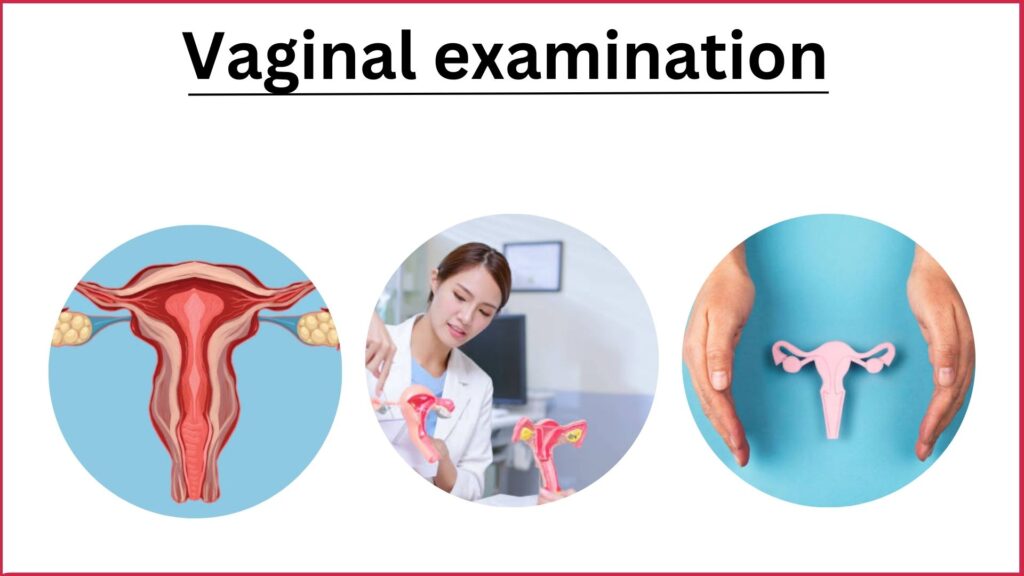vaginal examination : Define, indications & steps
Vaginal examination
We have described in article :
Definition of vaginal examination
Indications of vaginal examination
pre - requisites for vaginal examination
Steps of vaginal examination

Define Vaginal examination / per speculum examination :
Per speculum examination : A speculum examination is one method for visualizing the cervix, or opening of the uterus, and the interior walls of the vagina. It is normally performed in context of a total pelvic examination. Though it may sound frightening or very serious, it is generally not an uncomfortable thing, though some women attest to slight discomfort and the exam usually only takes a minute or two.
Common gynaecological indications of per vaginal examination :
- Menstrual abnormality :
. Puberty menorrhagia.
. Amenorrhoea.
.Cryptomenorrhoea.
- Dysfunctional uterine bleeding (DUB).
- Hydatidiform mole.
- Choriocarcinoma.
- Uterovaginal prolapse.
- Fibroid uterus.
- Endometrial carcinoma.
- Carcinoma cervix.
- Ovarian tumour.
- Abortion.
- Vesico vaginal fistula (VVF).
Pre-requisites for P/V examination :
- Bladder must be empty.
- A female attendant (nurse or relative of the patient) should be present by the side.
- To examine a minor or unmarried, consent from the parent or guardian is required.
- Lower bowel (rectum and pelvic colon) should preferably be empty.
- A light source should be available.
- Sterile gloves, sterile lubricant (without any antiseptics), speculum, sponge holding forceps and swabs are required.
Common positions of gynaecological examination/Per vaginal examination :
- Sim’s position.
- Dorsal position.
- Lithotomy position
Steps of per vaginal (P/V) examination :
- PV examination is done using a gloved index finger lubricated with sterile lubricant.
- In virgins with intact hymen, this examination is withheld but can be employed under anaesthesia.
- This is done in dorsal position.
- The patient is asked to take deep breath to relax her abdominal & perineal muscles.
- The gloved right index & middle fingers are introduced through the introitus after separating the labia minora by the left index & thumb.
- The palmer surface of the left hand is then kept over the supra pubic region, which guides the right hand.
- Palpation of any labial swelling is made with the finger placed internally & thumb placed externally.
- The urethra is now pressed from above down for any discharge escaping out through the meatus.
- Palpation of the vaginal walls is to be done from below upwards to detect any abnormality either in the wall or in the adjacent structure.
Information that can be obtained from per vaginal/per speculum examination of a woman :
1). Any vaginal discharge.
2) The cellular debris from the cervix and the uterus is obtained for cytological study.
3) Inspection of the cervix for the pathological conditions such as :
- Erosion of cervix.
- Cervical polyp
- Carcinoma cervix
- Endometrial polyp
4) Inspection of the vault of the vagina to see –
- Endometriotic cyst of the posterior fonix.
- Granulation tissue at the vault etc.
5) Collection of discharge
6) Scraping from the ectocervix for cytology.
7) Sim’s speculum can be used to see the vaginal walls and associated pathology such as –
- Rectocele
- Enterocele.
- Vaginal cysts etc.
Indications of per vaginal examination in a labour patient :
Indications of P/V/E or digital vaginal examination : Per-vaginal examination should be restricted to a minimum.
- On admission for baseline data.
- At the onset of labour to confirm it and to detect precisely the presenting part should be done during the initial examination in a primigravidae).
- At every 3-4 hours interval to determine labour progress.
- & its position (P/V/E
- Following rupture of the membranes in labour (to exclude cord prolapse, specially where the head is not yet engaged).
- Whenever any interference is contemplated.
- To confirm the actual coincidence of bearing down efforts with complete dilation of the cervix & to diagnose precisely the beginning of 2 stage.
- Before analgesia (to determine progress)
- Upon auscultation or observing non-reassuring fetal heart rate.
- An initial D/R/E may be performed before the speculum examination for baseline data.
Types of per speculum examination :
Two types of speculum are commonly used-
- Sims
- Cusco’s bivalve
“Position of the patient : While in dorsal position, Cusco is widely used but in lateral position, Sims’ variety got advantages.
Structures seen :
- The cervix is best visualized with the Cusco’s variety
- Vaginal fomices are only visualized by Cusco.
- The anterior vaginal wall is to be visualized by Sims’ variety
- Sims speculum is advantageous in cases of genital prolapse.
Purpose :
- Inspection and identification of pathology of vagina and cervix.
- Collection of the discharge from the cervix or from the vaginal fornices or from the external un meatus is taken for bacteriological examination.
- To take cervical scrape cytology and endocervical sampling for cytological examination.

What i don’t understood is in fact how you are now not actually a lot more well-preferred than you might be now. You’re very intelligent. You know therefore considerably relating to this subject, produced me for my part imagine it from a lot of various angles. Its like women and men are not fascinated unless it’s one thing to do with Lady gaga! Your personal stuffs nice. All the time take care of it up!
I like this web site it’s a master piece! Glad I noticed this ohttps://69v.topn google.Expand blog